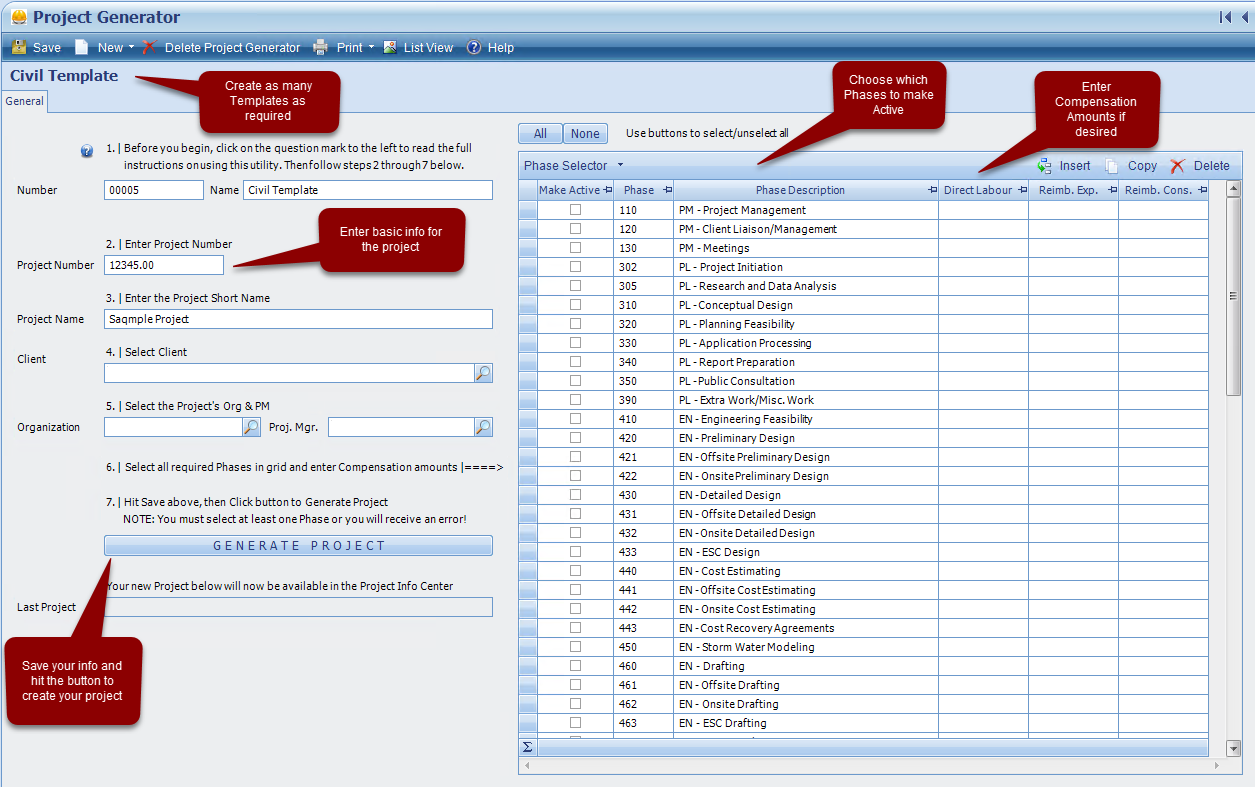“If your firm uses a large standardized Work Breakdown Structure (WBS) or requires projects to only have Phases and Tasks from a set naming/numbering nomenclature then standard Project Templates are probably causing bottlenecks.”
Complex Work Breakdown Structures in Deltek Vision
Many of the clients we work with maintain very large 2 and 3 level Work Breakdown Structures (WBS) for their projects. For multi-discipline firms they may have Phase and Task codes specific to each discipline and they will have a combination of Tasks that are common across disciplines as well as ones unique to each. This can mean projects with as many as 50 or more sub-levels!
Some will use Vision’s built in Project Templates as a way to ensure only the correct Phases and Tasks are used however many find this approach cumbersome for a few reasons:
- Often many templates are required for the various disciplines or different types of projects which can get confusing and difficult to maintain over time.
- What happens if you want to use standard Phases and Tasks but only the ones that are required? If you use a template that has every possible option you then have to then go back and delete the unnecessary Phases/Tasks or make them Inactive – neither is ideal.
- Small changes to naming or numbering of Phases and Tasks must be updated across all of the templates!
In this post we will explain a custom solution we developed for a client that we are now offering as a packed solution called Project Generator.
Standardizing WBS While Maintaining Flexibility
The first problem that needed to be solved was to give the client the ability to build and maintain their own WBS naming and numbering structures and provide a simple way to create a project from these “templates”. This was achieved by:
- Creating a User Defined Info Center (UDIC) to store 1 or more master lists of Phases and Tasks
- The Phases and Tasks are stored in a custom grid in the new info center with columns for Phase/Task Names and Numbers
- Each UDIC record represents a unique WBS list or “template”. This could be specific to disciplines, offices or even clients depending on the requirements.
- Default required fields for the project such as Project No., Name, Org, PM, etc. are included as custom fields
- A workflow button is used to generate a new project based on the template and information provided by the user.
- Depending on the requirements auto-numbering can be set up for the Project Number.
How is This Better Than a Template?
So you may be asking what makes this any more efficient than using a Vision Project Template. The big advantages lie in a few key features that we built in:
- An optional column can be included that lets the user pick which Phases/Tasks to include in the project. So while the Grid will list all of the standard Phases and Tasks, the user can ultimately decided which ones are needed. This means every project doesn’t have Phases and Tasks that will never be used or sit there in an Inactive state.
- Another optional column can be used that allows the user to determine the status of the Phases/Tasks at the outset. Many of our clients want all of the Standard Phases and Tasks on every project but only want relevant ones to be Active at the start of the project. This helps prevent incorrect time/expense charges to the wrong areas of the project.
- Another great feature we included was the ability to enter Compensation Amounts, such as Direct Labor, Reimbursable Expenses and Reimbursable Consultants from a grid view while you’re creating the project. This is a huge time saver from toggling through the Project Tree to enter this info later.
Managing Phase / Task Status
Another big complaint we hear from clients that have complex projects is that it’s very cumbersome and slow to change the Status of Phases and Tasks in bulk. If you have 10 Phases, each with many Tasks and you need to de-activate more than a few Tasks, it’s very time consuming to navigate to each one to change the status. List view unfortunately doesn’t work on sub-levels of projects.
A new feature that we added to the Project Generator utility, which can also be purchased as a stand alone add-on for the Project Info Center solves this problem. We now include a custom tab where you can quickly toggle between viewing Active / Inactive Phases or Tasks. From the list you can then select multiple Phases or Tasks to change their status.
This feature can also be purchased as a standalone product and will save a lot of time and frustration if you need to change Phase and Task statuses for large projects.
Conclusion
The Project Generator custom module is just one of the many custom tools we have developed to help our clients get more out of their Vision systems. We can tailor this to your specific needs or develop something unique for your firm. If you would like to learn more about this product and pricing please check out our Modules page.
If you would like to learn more about the Project Generator module or have other customization ideas send us an e-mail: in**@***************ns.com.


